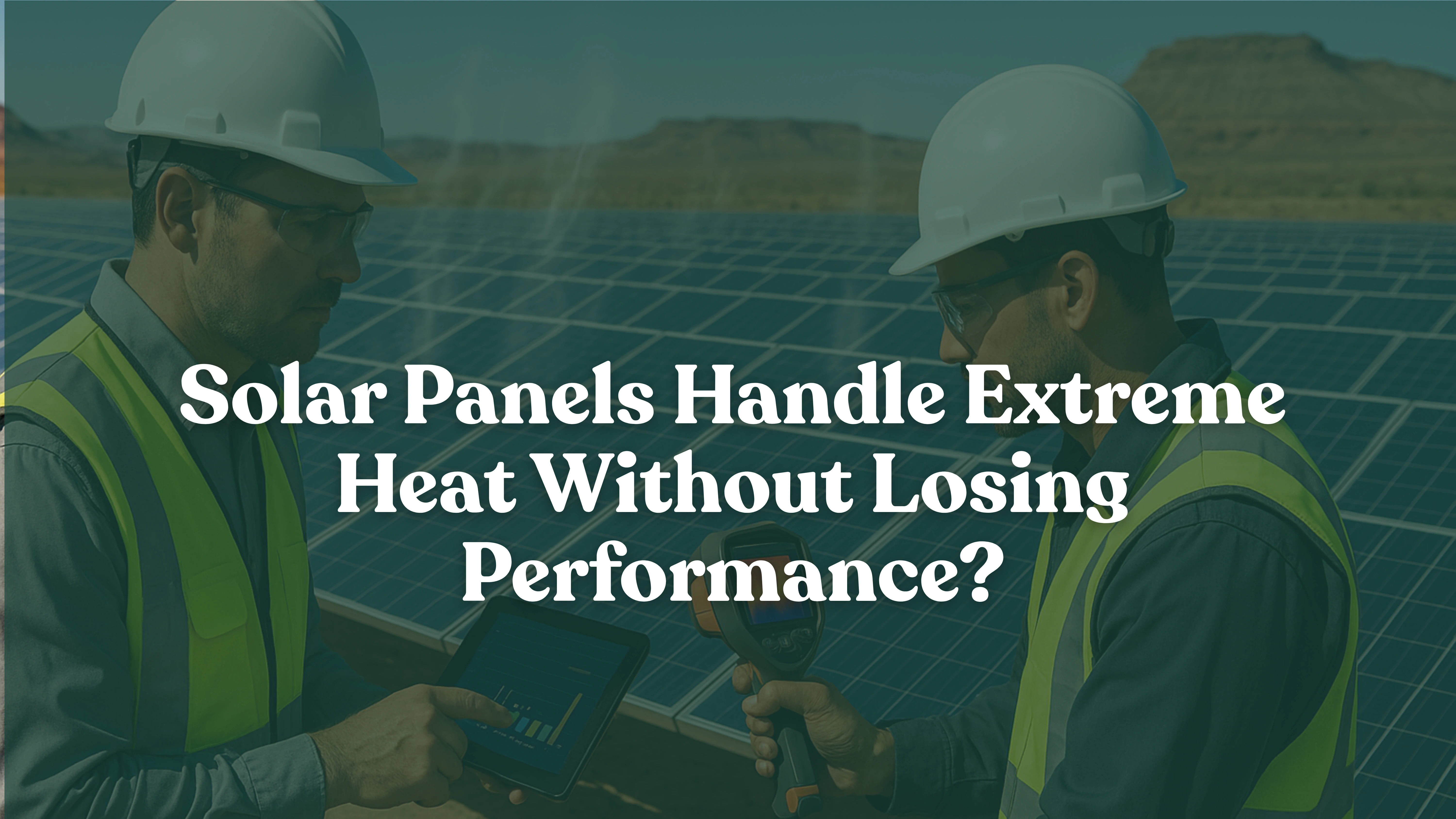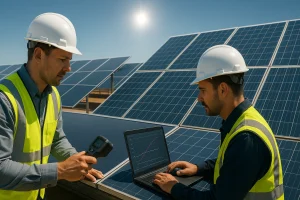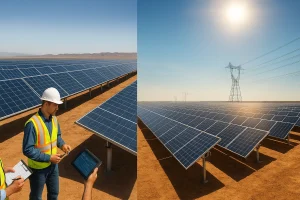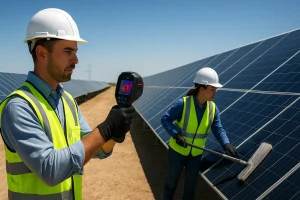Can Solar Panels Handle Extreme Heat Without Losing Performance?

Solar Panels & High Temperatures: What You Need to Know
Solar panels face a critical challenge that every installer knows: extreme heat can reduce efficiency by 10-25%, yet the hottest climates often deliver the best solar resources. For US solar installers and EPCs operating in scorching markets like Arizona, Nevada, Texas, and California’s desert regions, understanding thermal performance isn’t just technical knowledge—it’s the difference between profitable projects and costly callbacks.
The reality behind solar panels extreme heat performance is more promising than many realize. While high temperatures do impact efficiency, proper technology selection, installation techniques, and thermal management strategies can turn these challenging conditions into competitive advantages. Smart installers are discovering that heat-resistant technologies and proven cooling methods deliver exceptional returns in markets where others struggle.
Understanding Solar Panel Heat Performance and Temperature Coefficients
How Temperature Coefficient Affects Solar Panel Efficiency
The temperature coefficient measures power loss per degree Celsius above standard test conditions (25°C). This specification varies dramatically across technologies, from -0.24%/°C for advanced thin-film panels to -0.50%/°C for standard polycrystalline modules.

When solar panels reach operating temperatures of 140°F (60°C)—common for roof-mounted systems in desert climates—efficiency losses become substantial. Premium panels with -0.30%/°C coefficients lose approximately 10% efficiency, while conventional panels can drop 17% or more.
These differences create massive economic impacts. A 1MW installation experiencing 15% heat-related losses represents $22,500 in lost annual revenue, scaling to over $500,000 over the system’s lifetime. Temperature coefficient selection directly drives project profitability in hot climates.
Real-World Operating Temperatures vs. Standard Ratings
Solar panel operating temperatures consistently exceed ambient air by 25-45°F. While industry ratings suggest 110-115°F operation, field measurements in hot climates regularly show 140-160°F. Roof-mounted installations run significantly hotter due to reduced airflow and radiant heat, with poorly ventilated systems reaching 185°F in extreme cases.
Solar Panel Technology Comparison for High Temperature Performance
Premium Monocrystalline Solar Panels in Extreme Heat
Modern monocrystalline solar panels outperform alternatives in high-temperature conditions, with average coefficients of -0.30% to -0.35%/°C. Premium manufacturers like SunPower achieve -0.29%/°C while maintaining 22%+ efficiency ratings.
These panels demonstrate superior heat tolerance while delivering higher power density—critical for space-constrained commercial installations. The 0.10-0.20 percentage point advantage over polycrystalline technology compounds significantly over decades of operation.
Thin-Film Solar Panel Heat Resistance Technology
Thin-film technologies excel in extreme conditions, with cadmium telluride panels achieving -0.24%/°C coefficients. While requiring 25-30% more installation area, thin-film panels maintain stable performance where crystalline silicon struggles.
For utility-scale desert installations with abundant land, thin-film technology often provides superior long-term performance ratios. Real-world data from major installations shows thin-film panels maintaining 85-90% rated output after 15+ years in extreme climates.
Advanced Solar Panel Cooling Systems for Hot Weather Performance
Passive Cooling Installation Techniques
Proper mounting design creates natural convection through strategic spacing. Industry standards recommend 100-110mm air gaps between panels and surfaces, enabling 65% heat dissipation through convection. Enhanced aluminum mounting rails provide superior heat transfer compared to steel alternatives.

Advanced passive solutions include multi-level aluminum heat sinks reducing panel temperatures by 8.45°C while improving power yield 10.75%. These systems add $0.60/W installation cost but deliver compelling returns through enhanced performance.
Active Cooling Technologies for Commercial Solar
Water-based cooling systems show positive ROI in climates exceeding 30°C average temperatures. Microfluidic cooling with double-layer microchannel heat sinks demonstrates utility-scale potential, while hybrid PV-thermal systems achieve 15% efficiency improvements by capturing waste heat for building applications.
Installation Best Practices for Solar Panels in Hot Climates
Thermal Management Installation Standards
Installation excellence requires specific attention to airflow management. Elevated mounting systems allowing unobstructed air circulation across panel surfaces prevent heat buildup while maximizing space utilization. Row spacing must balance bifacial panel requirements with temperature management needs.
Quality protocols should include thermal commissioning with infrared inspections during installation to identify potential hot spots before they impact performance.
High Temperature Electrical Safety Requirements
Extreme environments demand enhanced electrical protocols. NEC Article 690 requires conductor ampacity corrections above 30°C, with all wiring meeting minimum 90°C ratings. Component failures accelerate at elevated temperatures, with bypass diodes failing above 128°C junction temperatures.
Real-World Solar Performance Data from Hot US Markets
Arizona Desert Solar Panel Performance Results
Arizona delivers exceptional solar resources at 7.34 kWh/m²/day despite extreme heat. The University of Arizona’s research facility operates 600+ modules from 20+ manufacturers, demonstrating consistent performance with 5-6 kWh daily generation per panel over 15+ years.

Commercial installations achieve 28-32% capacity factors despite heat losses, significantly exceeding moderate climate performance where lower irradiance limits generation.
Texas Solar Grid Performance During Extreme Heat Events
Texas grid data reveals solar’s reliability during heat waves. During record 85,931 MW peak demand in August 2024, solar provided 25% of midday power at 17,000 MW average output—42% higher than 2023 levels. This demonstrates solar’s value when air conditioning drives maximum electricity demand.
Economic Impact and ROI Analysis for Hot Climate Solar
Cost-Benefit Analysis of Heat-Resistant Technologies
Premium panels with coefficients below -0.30%/°C command 15-25% cost premiums but deliver $75,000-150,000 NPV advantages per MW in extreme climates. Enhanced mounting systems costing $0.10-0.25/W additional provide 3-8% efficiency gains with 4-7 year paybacks.
Heat mitigation investments demonstrate strong returns, with comprehensive thermal management reducing insurance costs 10-20% while improving long-term performance guarantees.
Maintenance Costs and Prevention Strategies
Maintenance expenses increase 25-40% in extreme heat due to accelerated aging. Monthly thermal imaging replaces annual inspections, with quarterly cleaning schedules in dusty environments. However, proactive thermal management reduces total ownership costs through prevented failures and enhanced performance.
Solar Panel Maintenance Excellence in Extreme Heat Conditions

Successful hot climate maintenance requires enhanced protocols including thermal monitoring, hot spot detection, and careful cleaning procedures preventing thermal shock. Comprehensive maintenance programs cost $200-600 annually but prevent major component failures while optimizing long-term yields.
Conclusion: Professional Thermal Management Drives Solar Success
Successfully managing solar panels extreme heat performance requires technical expertise and proven installation practices. Experienced professionals demonstrate that comprehensive thermal management transforms hot climates into highly profitable solar markets through proper temperature coefficient selection and cooling technologies.
Energyscape Renewables specializes in optimizing solar installations for extreme heat conditions across the American Southwest. Our expertise in thermal management, advanced mounting systems, and cooling solutions maximizes performance while minimizing degradation risks.
Whether planning desert installations or commercial rooftop systems, our thermal expertise ensures maximum ROI. Discover advanced solutions at Sunscape Solar for comprehensive solar technology resources.
Contact Energyscape Renewables today to transform extreme heat challenges into competitive advantages in the hot climate solar market.

sjayakanth@energyscaperenewables.com